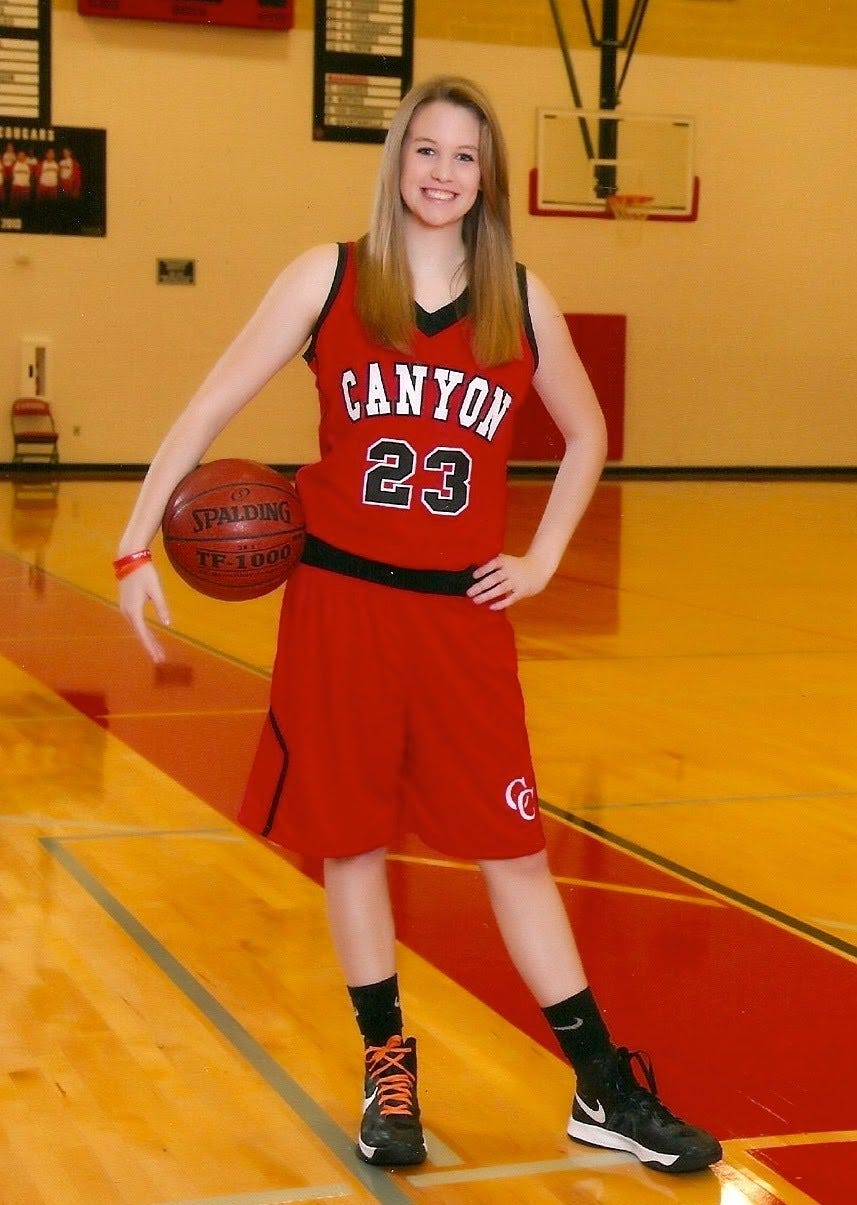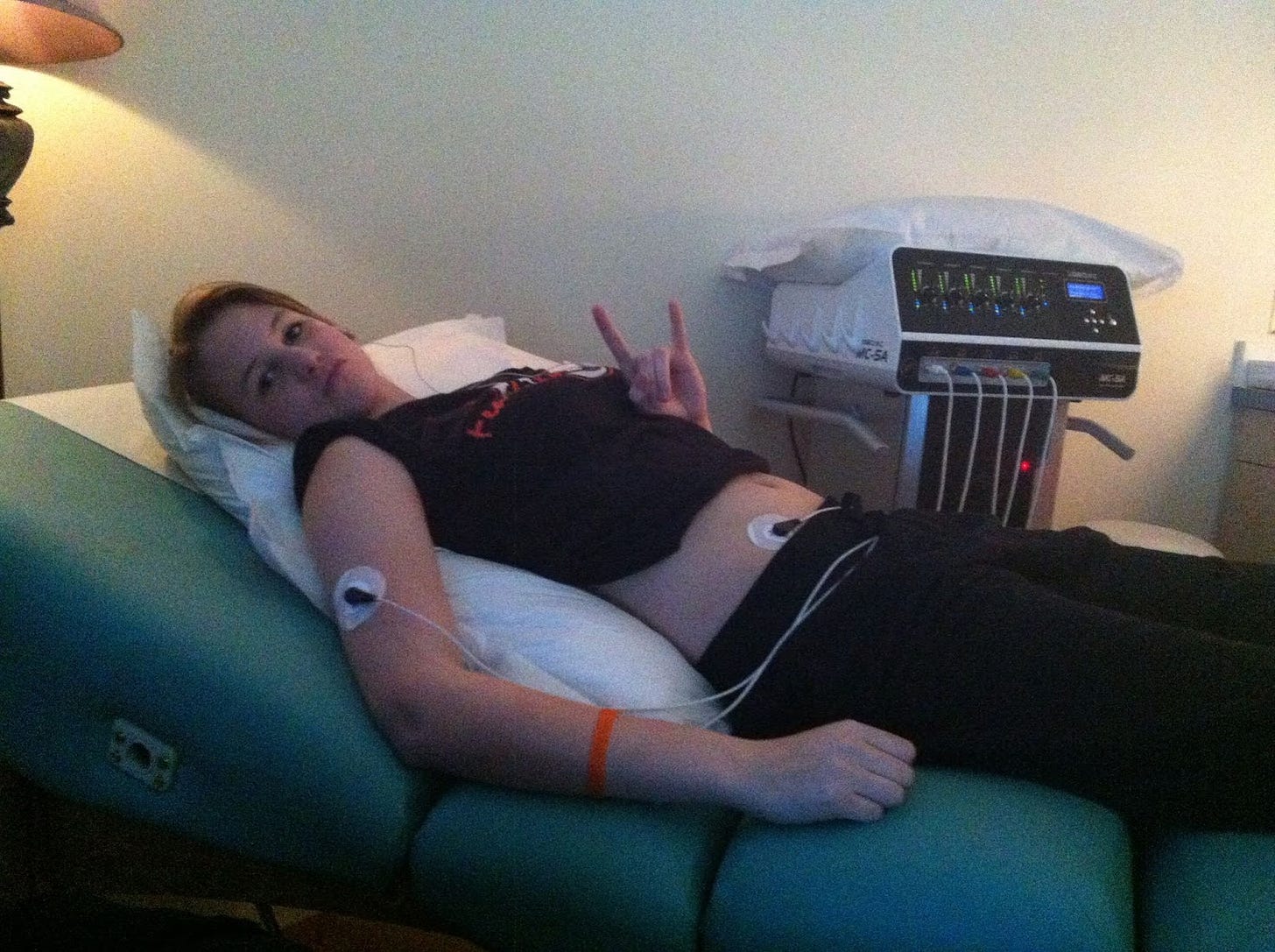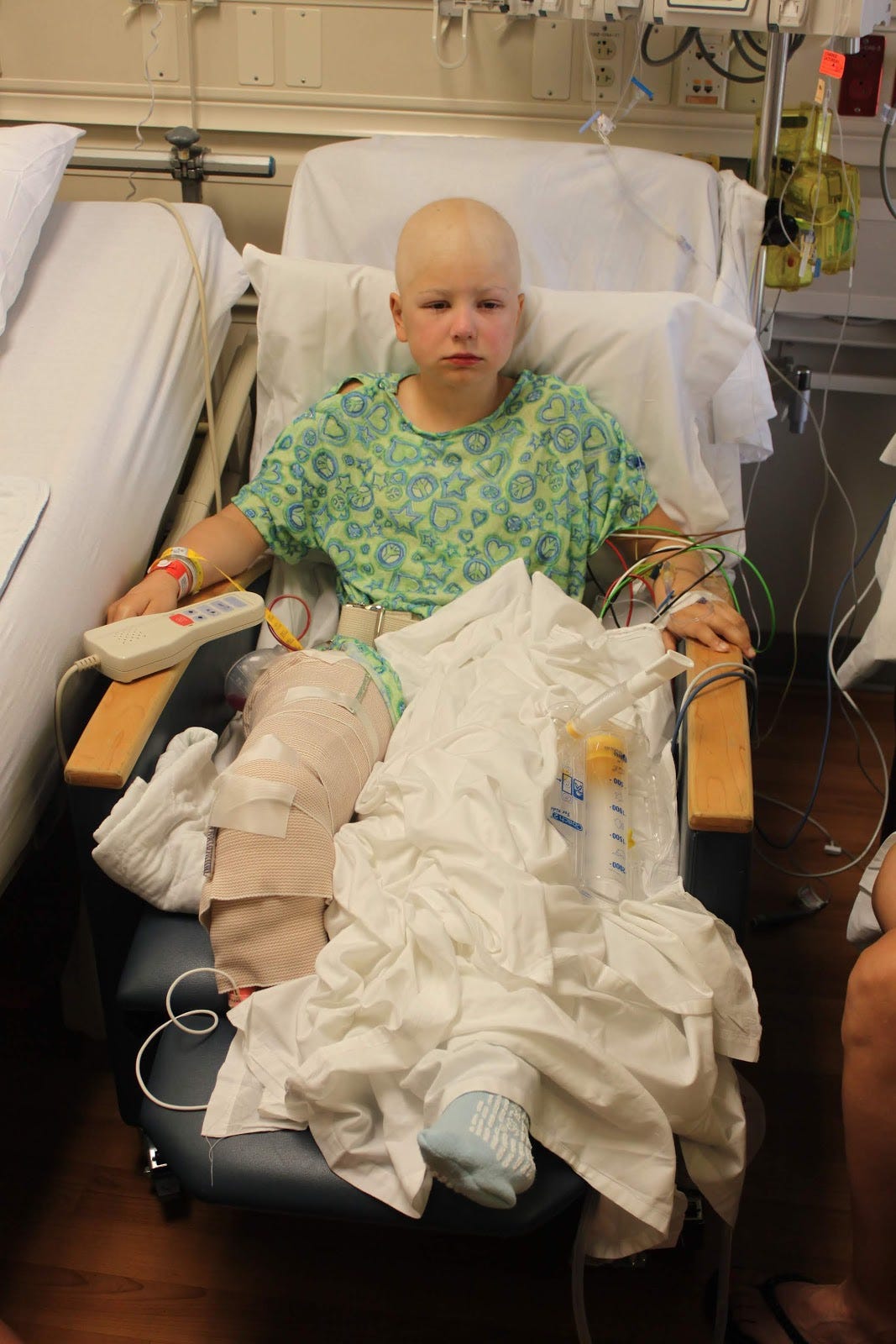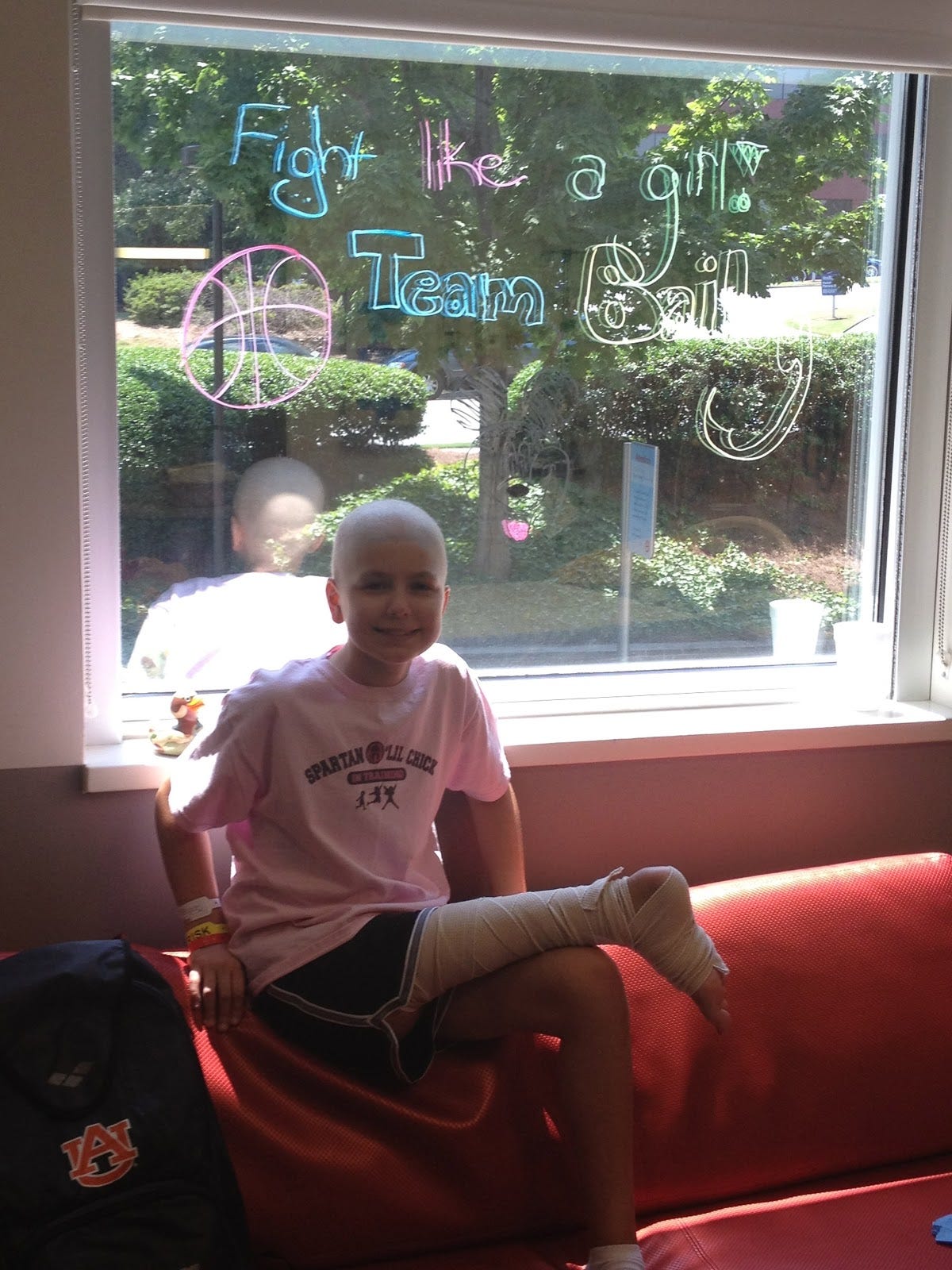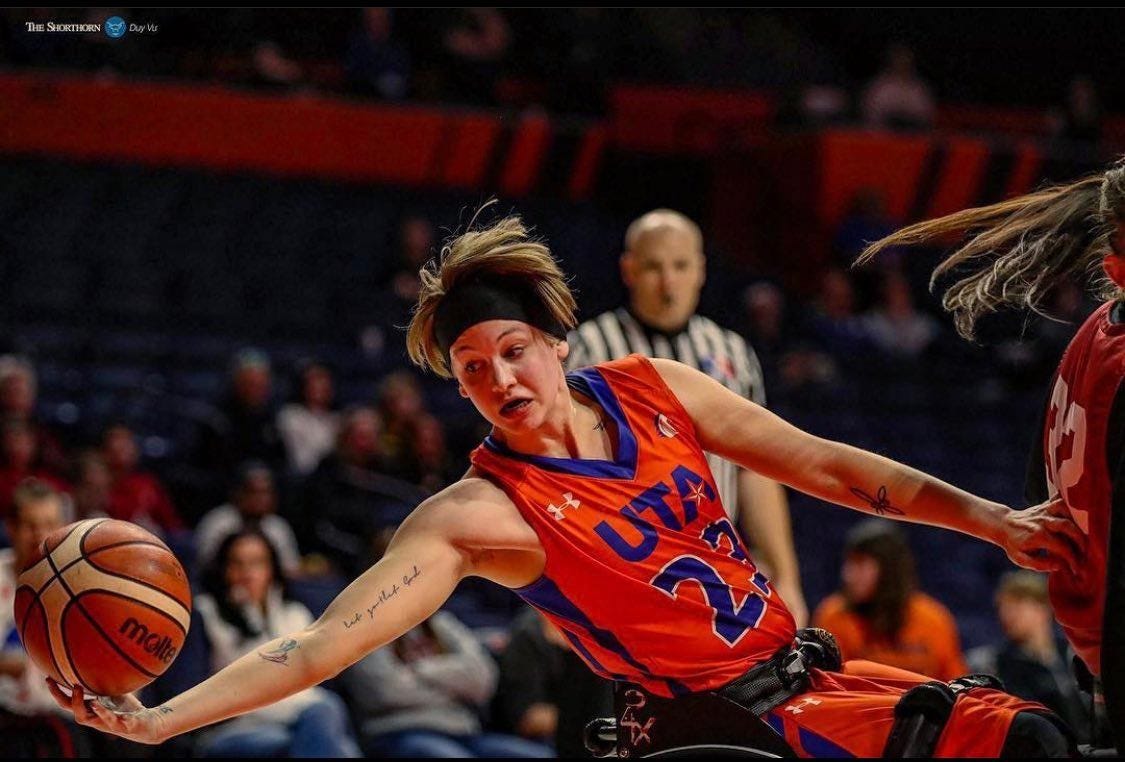“Will I Ever Be Able to Play Basketball Again?”
How Abby Dunkin and Bailey Moody went from almost losing the game they love to playing for Team USA
Thanks for reading the Her Hoop Stats Newsletter. If you like our work, be sure to check out our stats site, our podcast, and our social media accounts on Twitter, Facebook, and Instagram. You can also buy Her Hoop Stats gear, such as laptop stickers, mugs, and shirts!
Haven’t subscribed to the Her Hoop Stats Newsletter yet?
Basketball is a beautiful sport. More than just a sport, it's a culture, a community, a language, a religion. Basketball doesn't care who you are or who you know. You don't need bats, gloves, rackets or clubs; you don't need 11-person teams or a country club membership. It doesn't matter whether you're four or 94, rich or poor, Black or white, male or female … you got a ball and something to throw it in, you can hoop.


Basketball accepts everyone.
ABBY DUNKIN STILL remembers the exact time of the alarm she set. February 26, 2013, at 2:22 in the morning. It didn’t mean anything at the time, she says. “It was just random.” But it means something now.
Five years earlier, Abby was just a 12-year-old kid from New Braunfels, Texas, who loved Elvis, martial arts, and the San Antonio Spurs. Her favorite pastime, however, was shooting hoops. “Abby was basically glued to her basketball,” says her mother, Melissa Daugherty.
Her family’s financial situation didn’t allow her to play on an organized basketball team growing up — she had to wait until seventh grade for that — but she had a ball, she had a driveway, and she had a basketball hoop from Walmart.
“I would spend hours shooting on it,” she says. Even in the 90-degree heat of a Texas summer.
With Abby’s military father often gone, it was Daugherty who drove her everywhere. School, doctor appointments, martial arts clinics. It was those clinics where Abby excelled the most — she became a second-degree black belt in Tang Soo Do by age 14 after receiving lessons as a Christmas gift in first grade.
It was also at one of those clinics where Abby’s life changed forever.
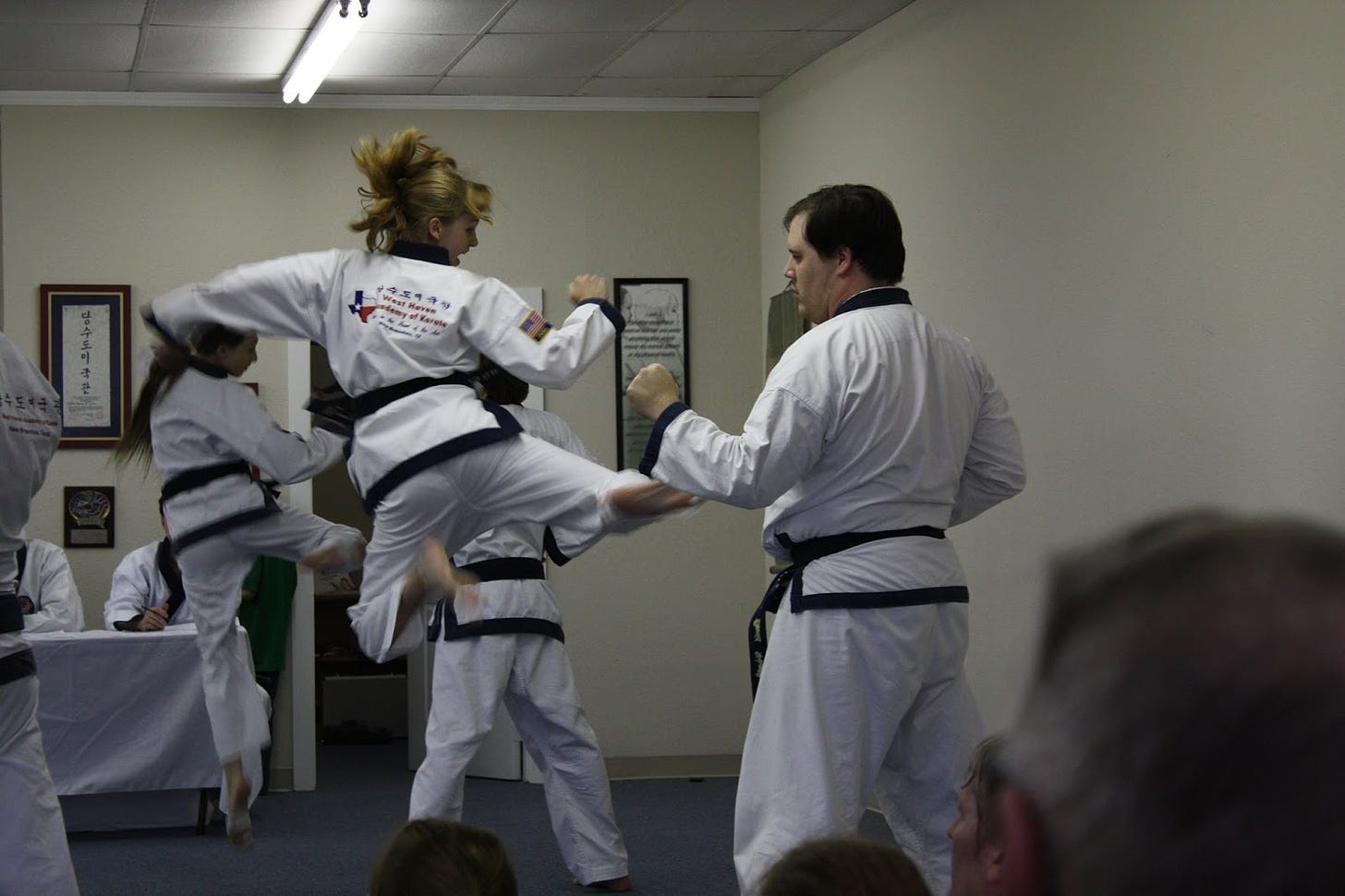
FOR BAILEY MOODY, the choice was easy. As soon as her parents finished listing the options, she knew exactly which procedure she wanted. As for Patrick and Tiffany Moody? The idea was going to take some getting used to.
“When you see it for the first time, especially if you’re going to consider doing that with one of your children, you’re crazy if you don’t admit that your first reaction is, ‘No way,’” Patrick says. “There’s no way I can do that, right? There’s gotta be a better way.”
But the Atlanta couple also knew their daughter, and they knew she was capable of making the right choice. “This was her decision,” Patrick says. “Even at 10, we felt like she was mature enough to make it.”
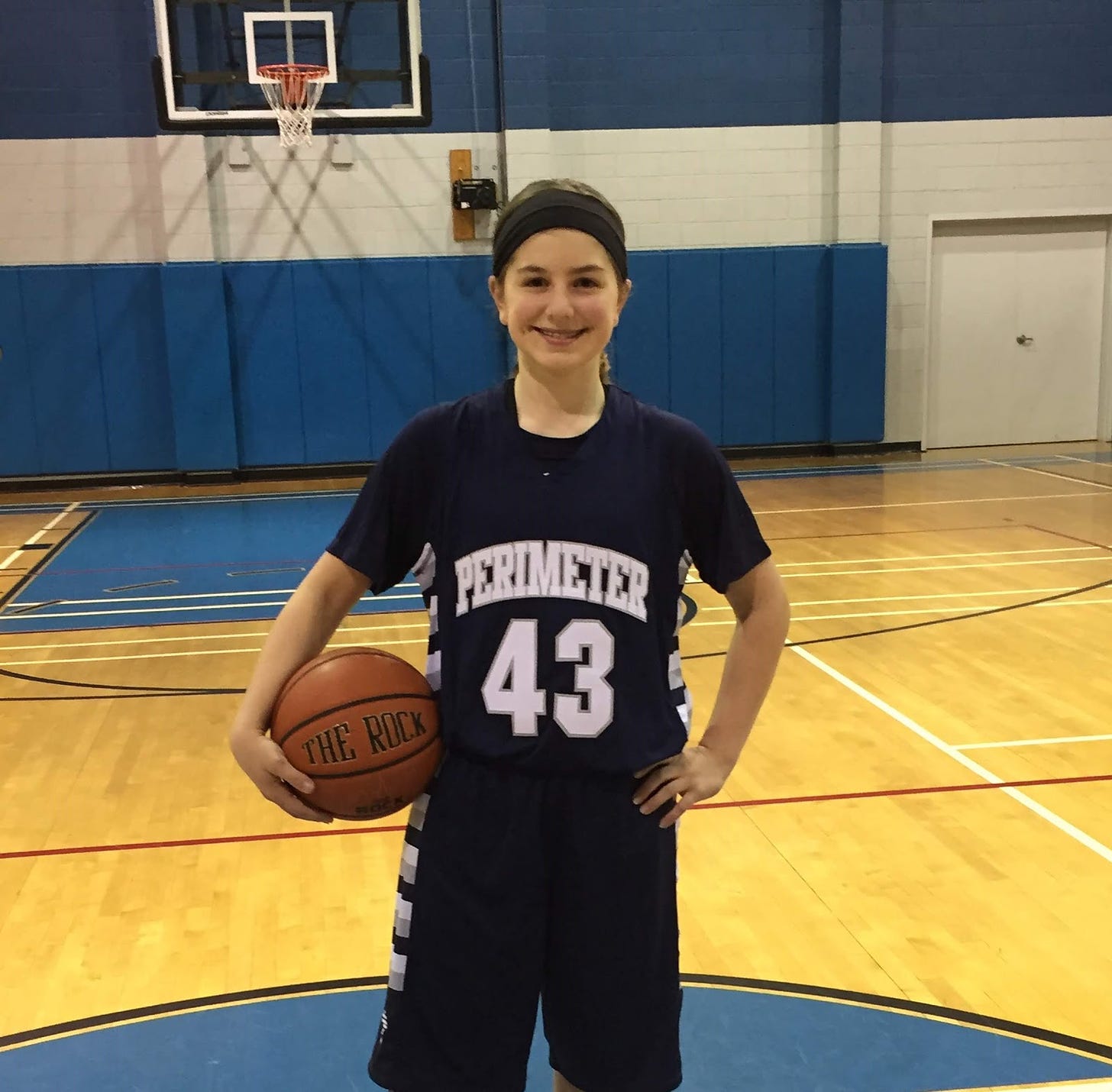
So the Moodys made it their mission to gather as much information as possible for Bailey. They traveled to visit specialists, they read, they asked questions, they learned. “My wife and I did a tremendous amount of independent research,” Patrick says. “We became experts on the topic.”
After weeks of studying, the time came to present Bailey with their findings. And Bailey didn’t hesitate. Eight years later, she doesn’t have any regrets.
PERHAPS NOWHERE IS the accessibility of basketball more evident than in its wheelchair form. Originally played by World War II veterans at Veterans Administration hospitals in 1946, wheelchair basketball has developed into what many would call the most popular adaptive sport in the world.
“Once somebody who has a physical disability comes out and plays one time, they’re hooked.”
—Atlanta youth coach Jason Joines
In 1949, the University of Illinois’ Dr. Timothy Nugent created the first collegiate team — the Gizz Kids — and founded the National Wheelchair Basketball Association (NWBA), of which he served as commissioner for 25 years. The growth of the sport has continued ever since — the NWBA now has over 180 teams between its youth, collegiate and adult divisions. Nonetheless, it’s a sport that is still fighting for recognition.
“Not a lot of people know about it,” says Jason Joines, a coach for Atlanta’s BlazeSports Jr. Hawks youth team. “Once somebody who has a physical disability comes out and plays one time, they’re hooked.”
The first Paralympics were held in Rome in 1960, with men’s wheelchair basketball as one of the inaugural events. The women’s game was added to the third Paralympic Games in 1968, in which the U.S. took bronze in Tel Aviv. The U.S. women’s team won its first gold medal in 1988 at the Seoul Games and has now won three of the last four.
ABBY’S SURGERY HAD been successful. After an awkward landing to a jump spin kick at a martial arts clinic had resulted in a torn left meniscus, her injury had physically healed. But the pain was still there. “I had it in my left knee, and then it went through my whole leg and spread to my right leg and then my lower back down,” she says.
“I couldn’t be in the car without screaming in pain due to a little bump.”
—Abby Dunkin
The following year was filled with trips to doctors’ offices and medical facilities. Bone scans, bloodwork, MRIs … “It took the doctors forever to figure out what it was,” she says. Despite all the tests, “nothing ever showed up.”
Abby was 13 when she finally received a diagnosis — Complex Regional Pain Syndrome, or CRPS. “With CRPS, once an injury heals, the brain still sends those pain signals for some reason,” she explains. Thus began a grueling four-year stretch of excruciating pain.
“I couldn’t be in the car without screaming in pain due to a little bump,” Abby recalls. What to most were the subtlest of everyday occurrences were to Abby agonizing throes — temperature changes, certain fabrics, water. “The rain would absolutely kill me,” she says. “My body was in this full-time flare.”
Even so, Abby resisted pain medication for much of high school. “With the side effects and everything, I didn’t want that making a huge negative impact,” she says. But at a basketball tournament in her junior year, she realized she needed help. “It just hurt so bad to even just wear my uniform.”
That winter, Abby began taking prescription pain medicine. In January 2013, she had two lumbar nerve blocks — injections of anesthetic to relieve chronic pain. One didn’t go as planned. “I kind of walked with a little limp for about a month,” she says. In February, she began another series of treatments called Calmare at a clinic in the Dallas area. It was a brand-new type of treatment, she was told, that had been brought over from Italy.
For an hour a day, five days a week for two weeks, Abby was hooked up to electrodes across her body. The goal, she says, was to scramble the pain messages that her brain was sending. On the first day, her doctor came into the room.
“If you really care about yourself and your well-being, you will never play basketball again,” he told her.
“I didn’t see the light at the end of the tunnel. Just more darkness.”
—Abby Dunkin
During that time, some doctors from another medical practice saw a blog Abby had been writing about her experience at the Dallas facility, so they gave her a call. “Be really careful what you’re doing there,” they warned her. “They’ve had patients come out of there in wheelchairs before.”
LIMB SALVAGE, amputation, rotationplasty.
Those were Bailey’s options. Three months earlier, the 10-year-old self-described “super-active tomboy kid” had been diagnosed with osteosarcoma, a rare form of bone cancer. The right knee soreness didn’t seem like much at first — Bailey played several sports. But Bailey’s aunt, herself a doctor, recommended that she get it checked out. On Sunday, March 11, 2012, Bailey went in for an X-ray. By Friday, she was on chemotherapy.
After spending the rest of the spring on chemo, Bailey was given three choices — limb salvage, amputation, or rotationplasty — in that order. Her immediate response?
“Why did you save the best for last?”
“People just kept getting faster and getting stronger, and I wasn’t getting any faster.”
—Bailey Moody
A limb salvage would have involved replacing the bone with a titanium rod. Everything would have looked the same on the outside, but it would not have allowed Bailey to be nearly as active as before. Hiking, swimming in the ocean, and several sports would be off the table. A full above-the-knee amputation would have cost her those activities as well. But the final option — a rotationplasty — would give her the most functionality and mobility. So it was a no-brainer.
Because she chose a rotationplasty, the bottom portion of Bailey’s leg was amputated, rotated 180 degrees, and reattached above her knee. In essence, her ankle now functions as her knee. “It’s 1,000 times better than having a manmade joint,” she says.
Following her June surgery, Bailey spent several more months on chemo. In the fall, she got fitted for her first prosthetic, which would allow her to get back to playing sports. Less than two months later, she was declared cancer-free, and by early 2013, she was back on the court.
The battle with cancer was over, but the adjustment period was just beginning. “I was kind of doing this little skip hop jump run thing trying to keep up,” Bailey says.
“I didn’t want to be considered disabled … I didn’t want any limitations to be put on me.”
—Bailey Moody
For a competitor, the limitations were challenging. “I like to be the best; I like to outwork people,” she says. “For me to not be able to do certain things right away just because I wasn't physically capable of it or I hadn't healed enough to do so, I think was the hardest part.”
As the next couple of years went on, things didn’t get easier. Fifth grade came and went, sixth grade came and went, and by seventh grade, a prosthetic was not enough. “I was getting frustrated trying to keep up on one leg,” Bailey says. “People just kept getting faster and getting stronger, and I wasn’t getting any faster.”
Then the Moodys found Lora Webster.
SAVE FOR A FEW necessary rulebook adjustments (there is no double-dribble rule), wheelchair basketball mirrors its able-bodied counterpart. More than two wheel pushes without a dribble is a travel, for example, and players’ wheelchairs are essentially part of their bodies for out-of-bounds or foul calls. The most significant added component to the wheelchair game is the classification system.
Players in collegiate and adult divisions are assigned a point value ranging from 1.0 to 4.5. The higher the rating, the less limiting the disability — a 4.5-point player typically has full trunk control and can walk. A team may have no more than 14 total points on the court at any one time. Junior players are divided into two classifications — J1 and J2 — and a Junior Division team may not exceed eight points on the court.
The NWBA’s Junior Division is split into two subdivisions — Prep and Varsity. Children as young as five compete in the 38-team Prep Division using 8.5-foot hoops, smaller balls, and no backcourt press. Once they turn 14, players transition to the Varsity Division, which has grown to include 50 teams.
“OH S***, what did I just do?”
It was February 26, 2013, and at 3 o’clock in the morning, Abby woke up her mom.
Two weeks prior, Abby’s doctor had told her that his nurse would be running her entire Calmare procedure. She soon learned that something was not quite right. “It turns out the nurse wasn’t actually a nurse; she was an office assistant,” Abby says. “After that, I couldn’t walk normally, and so we just up and left, and that was that.”
That was when Abby began using a wheelchair. But for a 17-year-old hooper with aspirations of playing at the next level, the reality was almost too much to bear. “I didn’t think anybody with a disability or an impairment could be athletic or play a sport and be active,” she says. “I really thought any chance of that was gone.”
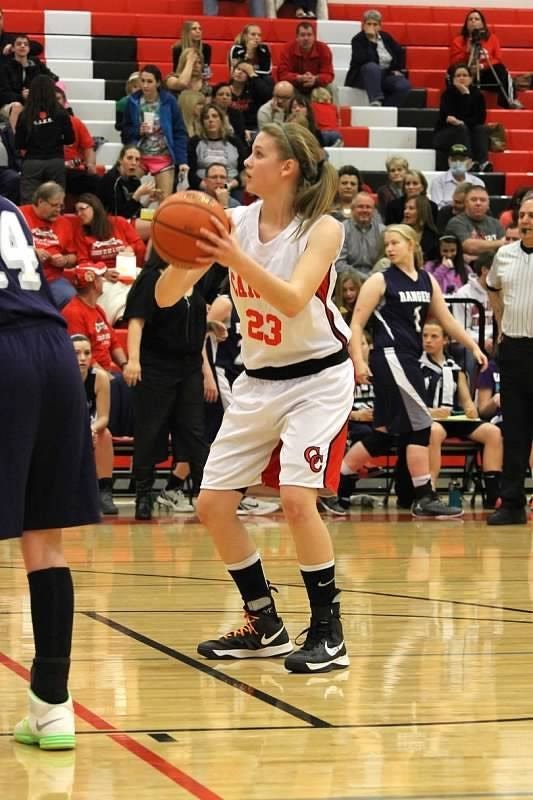
After four years of managing chronic physical pain, the emotional pain of giving up the sport she loved launched her into a deep depression. “I felt like I was a burden to friends and family that had to put up with that,” she says. “I didn’t see the light at the end of the tunnel. Just more darkness.”
On February 26, 2013, she set her alarm for 2:22 a.m. to carry out her plan. She had several different pain pills — many of which weren’t meant to be mixed. Abby overdosed that night in an attempt to take her own life. Had she gone back to sleep, she likely would not have woken up.
A few minutes later, Abby felt an inner voice. “This isn’t it; this isn’t your time,” it told her. “There’s something bigger and better along the way.” And so she woke up her mom.
WHEN PATRICK FIRST learned of his daughter’s diagnosis, he had lots of questions. Would he have an opportunity someday to walk her down the aisle? To know his grandchildren? To see Bailey graduate from college? From high school? “I wanted to save her life,” he says.
Bailey, on the other hand, had one question: “Will I ever be able to play basketball again?”
“I pretty much tried everything [growing up], and basketball was always the sport that I came back to,” she says. “It was my first love and just my favorite thing to do.”
“[Basketball] was my first love and just my favorite thing to do.”
—Bailey Moody
It was that love that made Bailey hesitant to give up stand-up basketball. When the Moodys met Lora Webster, a Team USA sitting volleyball player who had also had a rotationplasty, Webster introduced them to the concept of adaptive sports. But Bailey was skeptical. “I didn’t want to be considered disabled,” she says. “I didn’t want any limitations to be put on me.”
Webster understood — she had felt the same way when she initially learned about sitting volleyball. “At first I didn’t feel like I wanted to try it because I wanted to keep up with everybody else, but then I realized the opportunities that it has and how I get to travel the world now,” she told Bailey. “I wouldn't have been able to do that if I hadn't gotten involved in adaptive sports.”
It didn’t take long for Bailey to have the same change of heart. She attended a BlazeSports practice to get a feel for wheelchair basketball and left the practice sold. “As soon as I got in a chair, I loved it,” she says. “I’ve never looked back.”
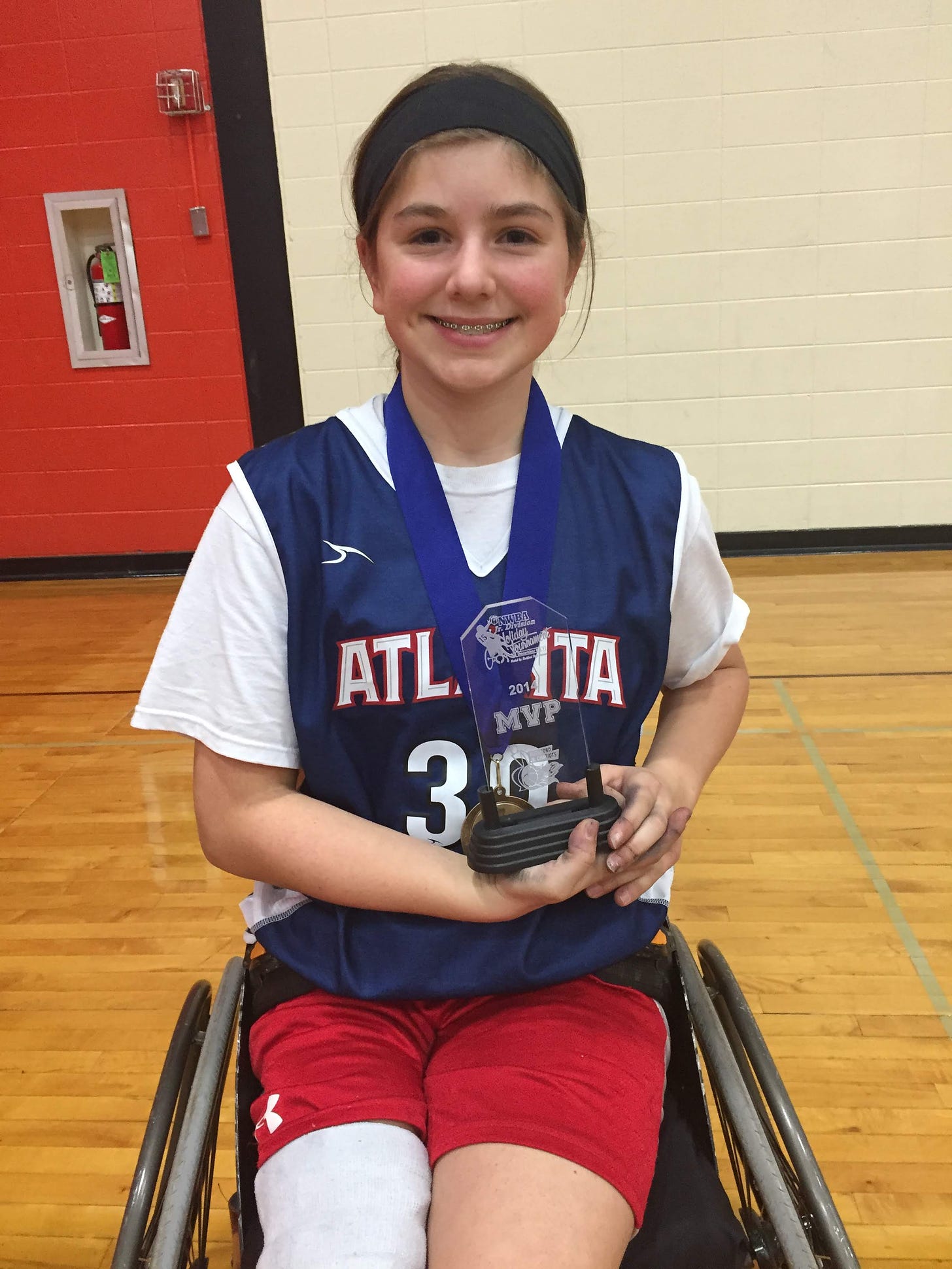
THE PUSH FOR equitable opportunities for women in sports is reflected in the evolution of the NWBA. Two decades after the 1949 launch of the Gizz Kids, the University of Illinois formed the first women’s collegiate team — the Ms. Kids. The NWBA officially added a women’s division in 1977.
The progress is evident, but there is much more to be made. The NWBA now has three adult divisions for men, which its website describes as “recreational level,” “mid-level,” and “elite level.” Division I alone has 30 teams. The women have one division with 12 teams, leaving players like Bailey to travel long distances to join the nearest squad. (Bailey’s talent first landed her a spot on the Charlotte Rollin’ Hornets women’s team in the adult division when she was 16.) The disparity exists at the collegiate level as well — 12 schools currently offer men’s wheelchair basketball; just five of them have a women’s team.
The good news for female players looking for a team is that the sport allows for women to compete on men’s teams and girls on boys’ teams. A woman competing with the men receives a one-point reduction in classification; a 4.5-point woman would become a 3.5-point player on the men’s side. In the junior divisions, the eight-point maximum is raised to nine if at least one girl is on the court.
The bad news for women is that this system doesn’t catalyze the growth of the women’s divisions. “Women are not going to the women’s college teams, because with one extra point they might get more playing time on the men’s team,” Joines says. The NWBA may soon remove the one-point rule, according to Joines, to “try to make it a true women’s division and to build that out.”
A FEW WEEKS after Abby’s mother rushed her to the emergency room, Abby was browsing YouTube and stumbled across videos of the U.S. wheelchair basketball team competing at the 2012 Paralympics. “I could not believe that they were playing a sport,” she says. “Basketball in chairs? I just remember thinking, ‘Wow, this is the coolest thing ever — I gotta try it!’”
Abby’s father took her to Fort Sam Houston to try out wheelchair basketball for the first time with recently-returned veterans who, like herself, were adjusting to life in a wheelchair. “I’m walking in as a 17-year-old scrawny white girl with these guys twice as big and twice my age,” she says. “I had no idea what I was getting myself into, but I fell in love with the game automatically.”
“In wheelchair basketball, nobody really cares who you pray for, what you pray for, who you love, or what the color of your skin is.”
—Abby Dunkin
Soon, Abby’s connections from the military base led her to the San Antonio Parasport Spurs, an NWBA Division II team. After spending her senior year of high school traveling and learning the game with the Parasport Spurs, she committed to play collegiately at the University of Texas-Arlington. She hadn’t even started her freshman year when Team USA came calling.
At a UTA summer camp in 2014, a Team USA assistant coach approached Abby and invited her to a Team USA developmental camp in Alabama that fall, even offering to pay for Abby’s flight. She accepted, and a few weeks after the camp in October, she received an invitation to try out for Team USA in 2015. “I almost emailed back saying, ‘Hey, thank you so much, but I think you have the wrong person. I don’t understand — I just started like a year ago; I have no idea what I’m doing.’”
Team USA had the right person — Abby made the team in 2015 and was on the court for the 2015 Parapan American Games in Toronto. One year later, she was wearing a gold medal at the 2016 Paralympics in Rio de Janeiro.
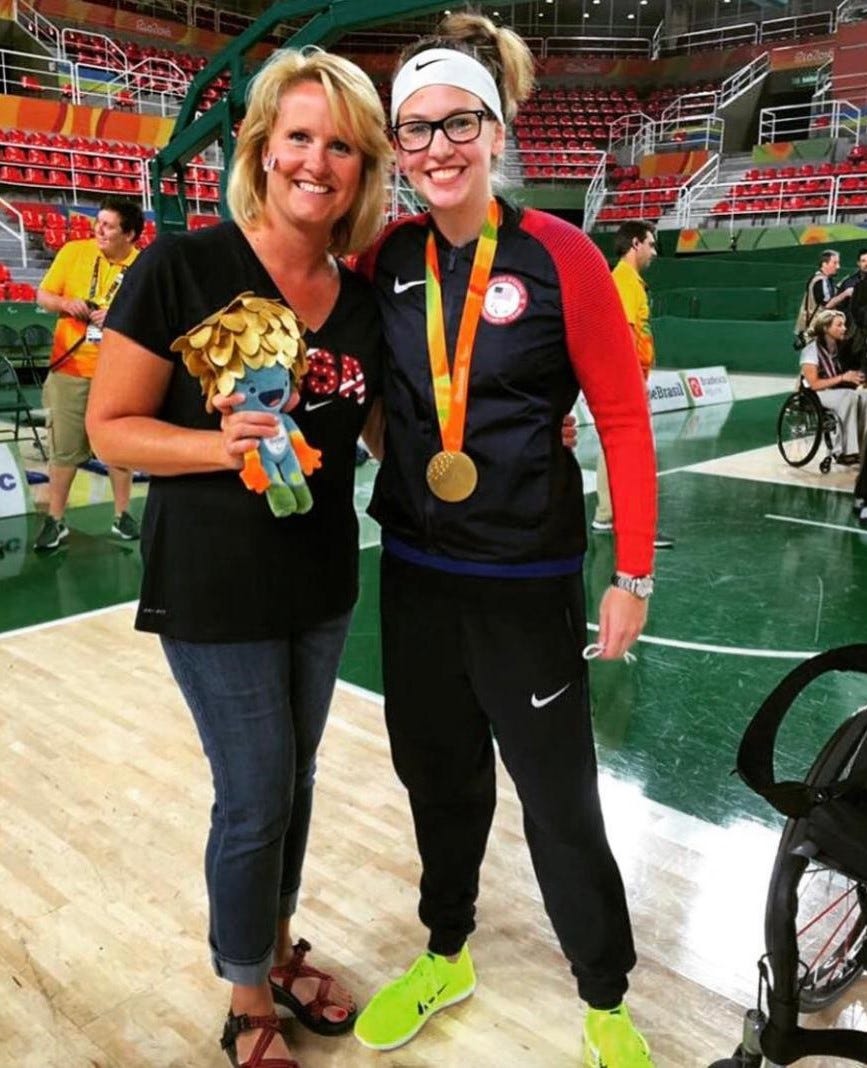
AFTER ATTENDING that first practice in seventh grade, Bailey joined the BlazeSports Jr. Hawks. The years since have been a whirlwind.
In November 2017, Bailey’s sophomore year of high school, she attended a Team USA developmental camp in Colorado Springs. Like Abby, she received an invite to try out for the team the following January. And like Abby, she didn’t think she was ready. “I thought that it might be a way to dip my feet in the water — get my name kind of out there — just for future purposes.”
But Team USA wasn’t interested in waiting. Bailey made the team then and there in January 2018. Come August, she was in Hamburg, Germany, competing alongside Abby in the International Wheelchair Basketball Federation (IWBF) World Championships.
“I like to be the best; I like to outwork people.”
—Bailey Moody
Wheelchair basketball has taken Bailey all over the globe — Germany, Peru, Thailand. Next international stop? Tokyo in 2021. The postponement of the Paralympic Games wasn’t anybody’s first choice, but Bailey is prepared to make the most of it. “I think it puts me in a really good position because of how young I am,” she says. At 18, Bailey is the youngest member of Team USA. “I’m excited for another year to train and get better and compete.”
In the meantime, Bailey will compete at the University of Alabama beginning in the fall, taking with her everything she's learned from the coaches she looks up to the most. Both her Charlotte Rollin’ Hornets coach, David Kiley, and her Team USA coach, Trooper Johnson, have storied playing careers. “They both know so much about the sport, so it’s been an honor to get to play under them and get to learn from them,” Bailey says. “They’ve increased my game and my ability so much.”
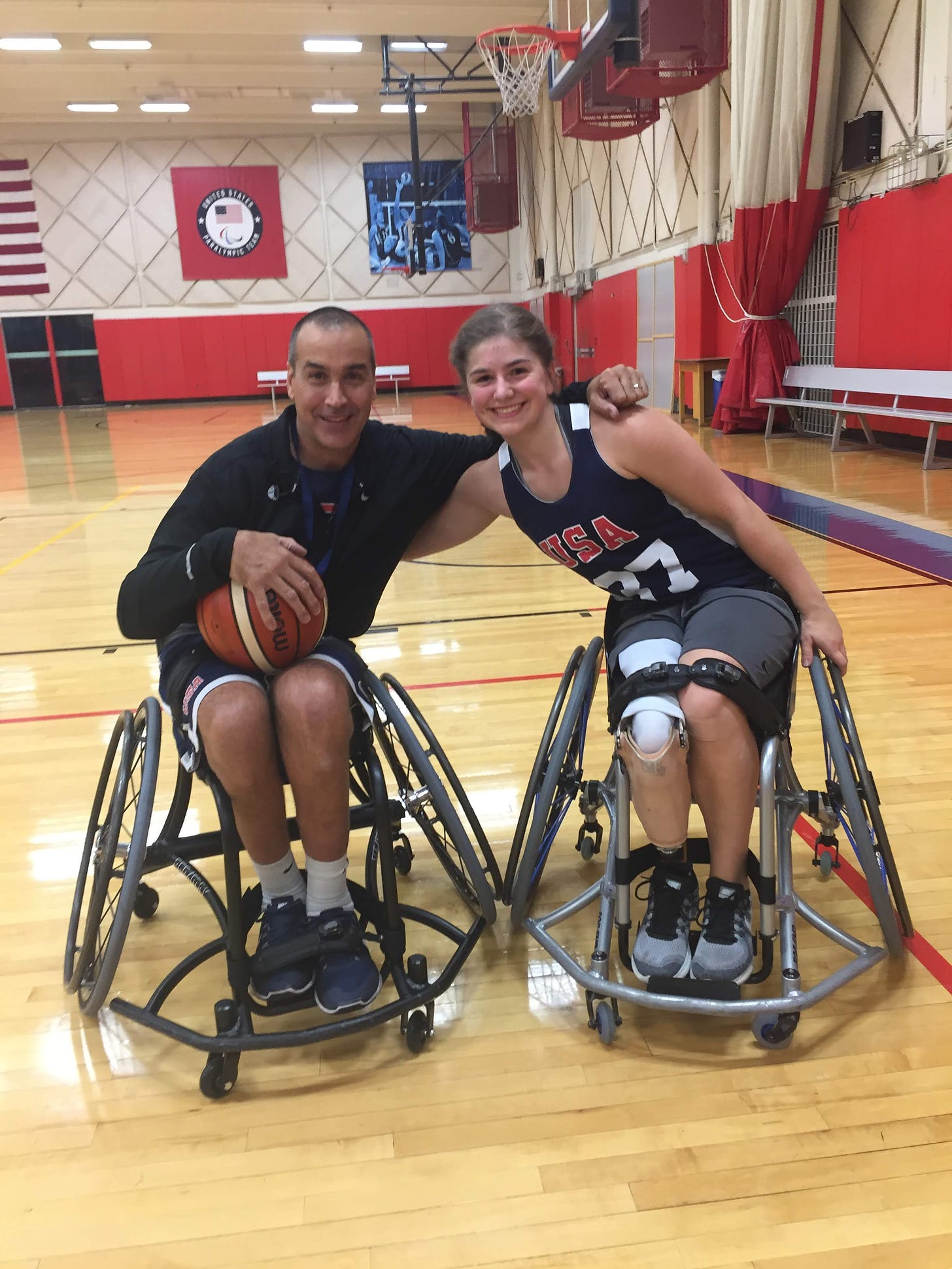
WHEN SHE REFLECTS on her journey since that nearly fatal night in 2013, Dunkin credits the game for saving her life. “In wheelchair basketball, nobody really cares who you pray for, what you pray for, who you love, or what the color of your skin is,” she says. “They just care that, ‘Hey, you can play ball. That’s more than enough.’ And so it really gave [me] a world that was very open and accepting.”
At age 24, Dunkin has experienced more adversity than many will face in a lifetime. But after shifting to a plant-based diet following open jaw surgery in 2019, she feels stronger than ever. “I didn’t realize how much of an impact that diet makes on not only your physical health but your emotional health [and] your spiritual health,” she says. “This is the first time that I’ve actually felt physically, mentally, and spiritually aligned.”
Dunkin had been planning on competing at the 2020 Paralympics in Tokyo, but after the games were moved to 2021, she decided it was time to call it a career. “I think wheelchair basketball for me was supposed to heal,” she says. “Wheelchair basketball did its job for me, and I can only hope that I did what I was supposed to for the game.”
“I think wheelchair basketball for me was supposed to heal.”
—Abby Dunkin
If what Dunkin did for the game on the court is memorable — she brought UTA its first two national titles and Team USA countless wins in international play — then what she did for it off the court is legendary.
Dunkin is an openly gay athlete and a role model for the LGBTQ community. During the summer of 2015, Dunkin publicly came out in a Facebook post, which she credits then-Team USA head coach Stephanie Wheeler, who is also openly gay, for giving her the courage to publish. “[I was inspired by] seeing her go off and do these great things and be successful … and she’s so well-respected nationally [and] internationally,” Dunkin says. “I thought, ‘You know what? If she can do that, I know that I can do that.’”
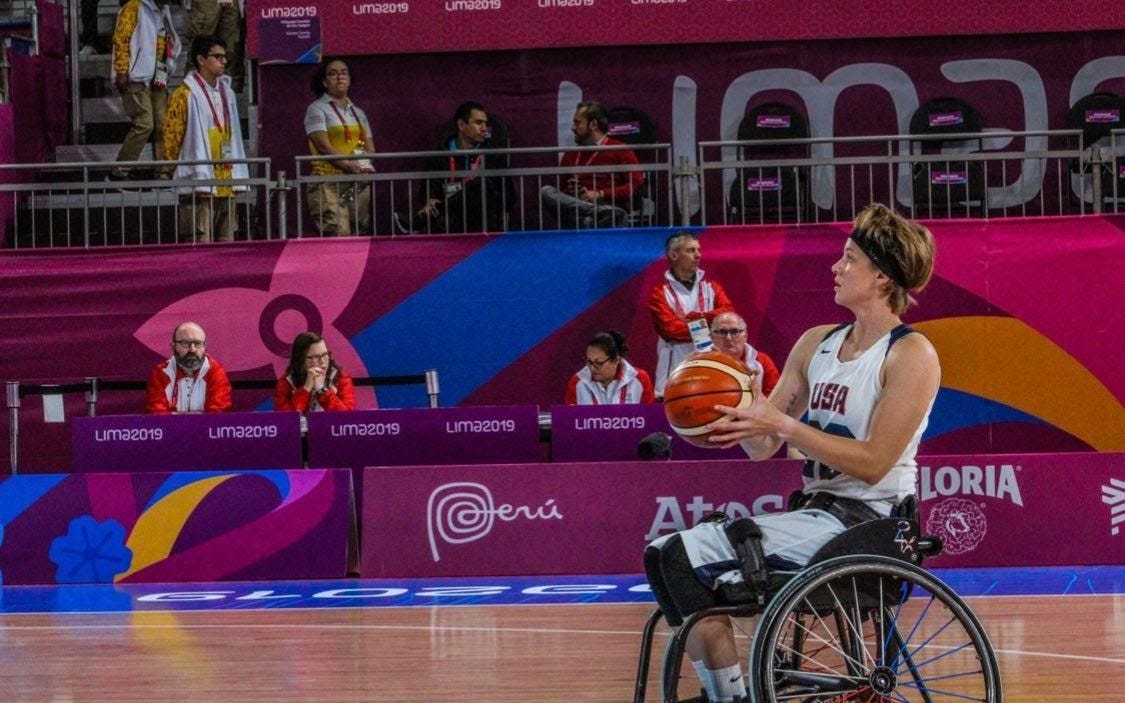
Dunkin also used her platform within the sport to bridge cultural divides. She tells the story of a time when she and some teammates approached a group of Middle Eastern sitting volleyball players at the 2016 Paralympics to trade pins — a common tradition at the Olympics and Paralympics. Upon hearing that Dunkin spoke English, the group became suspicious. “Oh, you’re American? Why are you talking to us?” one player asked. “Americans don’t like us.”
Dunkin noticed that one of the players was wearing Steph Curry basketball shoes. “Really cool shoes,” Dunkin told her. “Where’d you get them?” The players ended up not only trading pins, but also following each other on Instagram and becoming friends. “That was a huge eye-opening thing for me at the time,” Dunkin says.
Dunkin’s playing days are behind her, but she looks forward to the next chapter of her story having just as much of a positive impact. “I hope to give back to the sport in any way, shape, or form that I can,” she says. “I’d definitely love to go into coaching if that opportunity arises.”
“I hope to give back to the sport in any way, shape, or form that I can.”
—Abby Dunkin
It’s a profession that her mother envisioned for her ever since Dunkin’s grade school days in martial arts. “As she grew older and more experienced, she started to teach some of the younger kids,” Daugherty says. “It was easy to see her doing something in the coaching field.”
Regardless of what lies ahead for Dunkin, however, her influence will be felt for years to come through the next generation. “Abby is an incredible leader,” Moody says. “She explains things well, she’s a wonderful teammate, she’s with you to the end.”
When the Paralympic Torch Relay gets underway in 2021, it won’t be the only torch passed. Dunkin is ready to pass the leadership torch to Moody. “She’s got such a bright future ahead of her on and off the court,” Dunkin says. “I think she’s going to be a huge leader on the USA team.”
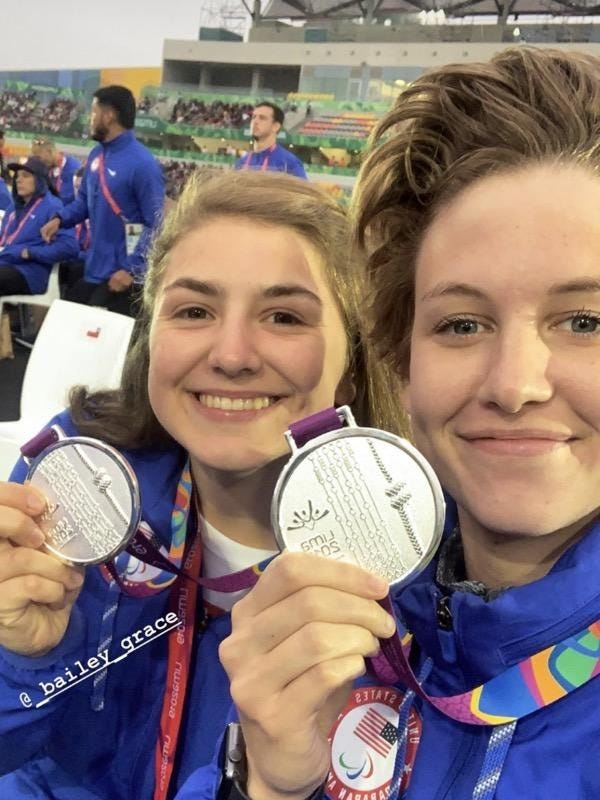
“Basketball is basketball.”
Bradley Beal put it best in his piece for The Players’ Tribune: “It really doesn’t matter who’s playing. Hoop is hoop. Game is game. If you have it, I’ll recognize it. Period.”
Watch them once and it’s clear — athletes like Abby Dunkin and Bailey Moody have game.
It’s time to recognize it.
If you are having thoughts of suicide, please call the National Suicide Prevention Lifeline at 1-800-273-8255 (TALK) or visit www.sprc.org.
Thanks for reading the Her Hoop Stats Newsletter. If you like our work, be sure to check out our stats site, our podcast, and our social media accounts on Twitter, Facebook, and Instagram. You can also buy Her Hoop Stats gear, such as laptop stickers, mugs, and shirts!
Haven’t subscribed to the Her Hoop Stats Newsletter yet?




